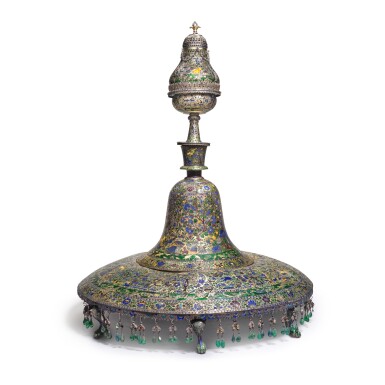Arts of the Islamic World & India including Fine Rugs and Carpets
Arts of the Islamic World & India including Fine Rugs and Carpets

A monumental gilt and polychrome enamelled silver huqqa, India, Lucknow, late 18th/early 19th century
Auction Closed
March 31, 12:40 PM GMT
Estimate
60,000 - 80,000 GBP
Lot Details
Description
comprising a bell-shaped bottle, sitting on a flared convex base standing on seven claw feet, the bulbous pierced burner with domed lid surmounted by bud finial, the base and burner with multiple green glass pendants, with detailed polychrome decoration, the base featuring a river with fish, alligators, crabs, heron, ducks, boats, elephants, lotus blossoms, below a central panel with birds amidst floral trees and foliage, with quadrupeds, hunting scenes, such as a tiger and gazelle, a horse rider, rams, peacocks, and architectural buildings
total height: 110cm.
huqqa: 27cm. height
diameter of base: 56cm.
The palette is the broadest of those found in Indian enamelling and includes blue, turquoise, green, aubergine, yellow and orange. The design features a wide range of fauna and flora - aquatic, on land and in the skies. Dr Manuel Keene has argued that this school of enamelling is developed from European prototypes in the early seventeenth century, probably in Hyderabad. Huqqas of this size and quality of enamelling are rare, this type of enamelling being more often seen on weapons such as a number of swords now in the Wallace Collection, London, inv. nos.1397, 1398, 1399, 1403 and 1412) but a closely comparable huqqa, now in the Indian Museum, Kolkata, inv. no.12931, is illustrated in ibid, p.209, no.83.
